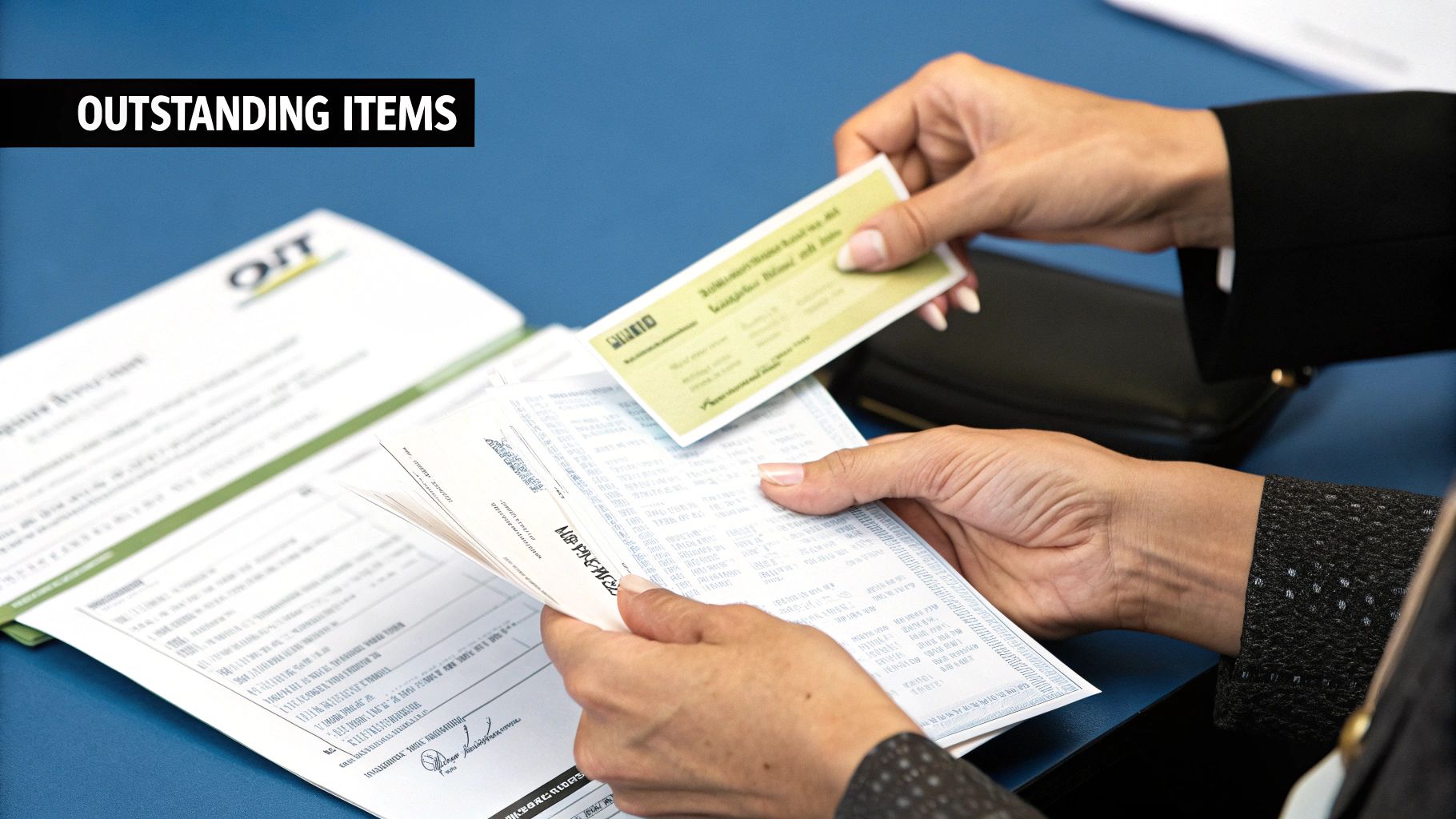8 Essential Bank Reconciliation Tips for 2025
Discover our top bank reconciliation tips to streamline your process, reduce errors, and improve financial accuracy. Perfect for businesses of any size.
Tags

Bank reconciliation doesn't have to be a dreaded monthly chore. It's a critical financial health check that ensures your books are accurate, catches potential fraud, and provides a clear picture of your cash flow. However, manual processes, missed transactions, and tiny discrepancies can quickly turn it into a time-consuming puzzle.
The secret to transforming this process from a headache into a powerful business tool lies in adopting a smarter, more structured approach. In this guide, we'll walk you through eight actionable bank reconciliation tips, blending timeless best practices with modern automation strategies. We'll show you how to build a rock-solid workflow that not only saves time but also enhances your financial controls.
We'll also highlight how platforms like GetInvoice can supercharge these tips, automating the tedious data capture and matching that often bog down finance teams. By the end, you'll have a clear roadmap to make your next reconciliation the smoothest one yet, giving you confidence in your numbers and more time to focus on strategic financial management. Let’s dive in.
1. Establish a Regular Reconciliation Schedule
Think of bank reconciliation like a regular health check-up for your finances. Putting it off only allows small, manageable issues to grow into major problems. Establishing a consistent, non-negotiable schedule is the single most effective foundational step you can take to maintain accurate financial records and ensure your business's fiscal health.

This practice involves setting aside dedicated time to systematically compare your internal bookkeeping records against your bank statements. The goal is to catch discrepancies early, from missed invoices and bank errors to unauthorized transactions, preventing a month-end fire drill. A disciplined schedule transforms reconciliation from a dreaded annual task into a simple, routine part of your workflow.
How to Implement a Reconciliation Schedule
The ideal frequency depends entirely on your business's transaction volume and complexity.
- •Daily Reconciliation: Best for high-volume businesses like large e-commerce stores or enterprises. Daily checks prevent backlogs and provide a real-time view of cash flow, which is critical for making informed operational decisions.
- •Weekly Reconciliation: A perfect middle ground for most small to medium-sized businesses. A weekly check, perhaps every Friday afternoon, is frequent enough to catch errors quickly without being overly burdensome.
- •Monthly Reconciliation: Suitable for businesses with lower transaction volumes, such as some nonprofits or small consultancies. This aligns well with monthly financial reporting cycles for board meetings or performance reviews.
Pro-Tip: Document your chosen schedule in your company’s standard operating procedures (SOPs). This creates accountability and ensures the process continues smoothly even when key personnel are on leave.
Automating this process with a tool like GetInvoice can make even a daily schedule feel effortless. By automatically fetching bank feeds and matching transactions against invoices, the system does the heavy lifting for you. This means your "reconciliation time" is spent reviewing exceptions, not manually ticking off hundreds of matching entries, making this one of the most powerful bank reconciliation tips to implement.
2. Maintain Detailed and Organized Records
If a regular schedule is the foundation of good reconciliation, then detailed records are the bricks and mortar. Simply having a transaction listed isn't enough; you need a complete audit trail. Proper record-keeping involves systematically documenting every financial event with complete details, including dates, amounts, clear descriptions, and supporting documentation like receipts or invoices.

This meticulous approach creates an easy-to-follow path from your internal books to your bank statement, making it simple to trace and verify every single line item. When a discrepancy appears, organized records mean you can pinpoint the source in minutes, not hours. Beyond bank statements, a robust system for all financial documentation is essential for accurate reconciliation and for broader financial compliance, including effective tax record-keeping.
How to Implement Organized Record-Keeping
A clean, consistent system is your best defense against reconciliation headaches. The key is to capture enough detail to make every transaction instantly understandable.
- •For QuickBooks Users: Go beyond basic categorization. Use the memo field to add specific details, like "Catering for Q3 client event" instead of just "Meals & Entertainment."
- •For Spreadsheet Users: Maintain dedicated columns for check numbers, payment method, vendor, purpose, and date. This structured data is much easier to sort and filter when searching for a specific entry.
- •For Physical Documents: If you still handle paper, use a filing system organized by month and then by transaction type (e.g., "October - Office Supplies," "October - Utilities"). For more advanced strategies, learn more about how to organize receipts effectively.
Pro-Tip: Consistency is crucial. Establish and use a uniform naming convention for all your transaction descriptions. For example, always list the vendor first, followed by the invoice number (e.g., "Supplier Inc. - INV-1234").
Tools like GetInvoice make this process virtually automatic. By scanning invoices and receipts, the system digitizes and categorizes the data for you, attaching the source document directly to the transaction. This eliminates manual data entry and ensures your records are always detailed, organized, and audit-ready, making it one of the most powerful bank reconciliation tips for maintaining financial clarity.
3. Verify Outstanding Checks and Deposits
One of the most common sources of discrepancies during reconciliation is timing. Meticulously tracking checks you've written that haven't been cashed and deposits you've made that haven't yet processed is essential. This step addresses these "in-transit" items, which create a temporary, legitimate difference between your books and the bank's records. Ignoring them leads to an inaccurate picture of your true cash position.

Properly managing these timing differences is crucial for accurate cash flow forecasting and preventing embarrassing situations like bounced checks or unexpected overdraft fees. For example, a construction company might issue several large checks to subcontractors on a Friday. While these are immediately deducted in their accounting software, they won't clear the bank until the following week, creating a temporary gap that must be accounted for.
How to Manage In-Transit Items
Effectively tracking these items requires a systematic approach to ensure nothing falls through the cracks.
- •Outstanding Checks: These are checks you have recorded as paid in your ledger but have not yet been presented to your bank for payment. A service-based business might find a client holds onto a check for weeks before depositing it. It's vital to keep this amount earmarked in your cash balance.
- •Deposits in Transit: This refers to funds, like cash or checks, that you have received and recorded but are not yet reflected in your bank statement. A classic example is a retail store making a deposit on a Saturday; the funds won't appear in the bank's records until Monday.
Pro-Tip: For checks that remain outstanding for an extended period (e.g., over 90 days), it's wise to contact the payee. The check may have been lost. If it cannot be resolved, you may need to follow your state's escheatment (unclaimed property) laws.
Automated systems like GetInvoice offer one of the best bank reconciliation tips for this challenge. Instead of manual tracking, the platform can help flag transactions that clear long after being issued. When a check finally clears, the system can match it to the original entry from weeks or months prior, simplifying what is often a tedious manual search and closing the loop on old items.
4. Use Bank Reconciliation Software or Templates
Manually reconciling accounts using pen and paper is not only tedious but also highly prone to human error. Leveraging technology, whether through dedicated accounting software or standardized spreadsheet templates, is a game-changer for efficiency and accuracy. These tools are designed to streamline the entire process, turning a complex chore into a manageable task.

This approach replaces manual data entry and comparison with automated features, calculation verification, and consistent reporting. For instance, small businesses often rely on QuickBooks' automatic bank feed reconciliation, while larger corporations might implement enterprise solutions like SAP. The core benefit is the same: reducing manual effort, minimizing mistakes, and creating a clear, auditable trail.
How to Implement Reconciliation Tools
Selecting and implementing the right tool is key to unlocking its full potential. Your choice will depend on your business size, transaction volume, and technical expertise.
- •Spreadsheet Templates: Ideal for startups or freelancers with very low transaction volumes. A well-designed Excel or Google Sheets template with built-in formulas can provide structure and basic automation without any financial investment.
- •Accounting Software: The standard for most small to medium-sized businesses. Platforms like Xero, QuickBooks, and Wave offer features like direct bank feeds, automated transaction matching, and reconciliation reports, making the process significantly faster and more accurate.
- •Enterprise Resource Planning (ERP) Systems: Necessary for large corporations that need to integrate reconciliation with other financial modules like accounts payable, accounts receivable, and general ledger management.
Pro-Tip: Before committing to paid software, test the waters with a free trial or a basic free version. This allows you to assess its user-friendliness and ensure it integrates smoothly with your bank and existing systems.
Automated platforms like GetInvoice take this concept a step further by focusing on the entire invoice-to-payment lifecycle, which simplifies reconciliation downstream. When your invoicing and payment data is already clean and organized, the final reconciliation becomes a quick confirmation step. This is one of the most powerful bank reconciliation tips because it fixes issues at the source. If you're interested in streamlining your financial workflows, you can learn more about how to automate bookkeeping on get-invoice.com.
5. Investigate and Document All Discrepancies
Finding a discrepancy during bank reconciliation can feel like hitting a roadblock, but it's actually an opportunity to strengthen your financial controls. Systematically investigating every variance, no matter how small, is a critical step that ensures your books are not just close but completely accurate. This process transforms reconciliation from a simple matching game into a powerful diagnostic tool for your business's financial health.
The core practice involves tracing each difference back to its source, whether it's a simple bank fee, a timing difference, or a more complex issue like a duplicate payment. Properly documenting your findings creates an essential audit trail, providing clarity and proof of resolution for future reviews, audits, or internal questions. This discipline prevents lingering mysteries in your financial statements.
How to Systematically Investigate Discrepancies
A structured approach prevents oversights and ensures every issue is resolved correctly. The goal is to create a clear, repeatable process.
- •Retail Scenario: A retail business might find its bank statement shows service charges or card processing fees that weren't recorded in its accounting software. The investigation involves identifying these fees and creating corresponding journal entries to account for the expense.
- •Nonprofit Scenario: A nonprofit could discover a large donor check was deposited at the bank but never entered into its internal donation tracking system. The investigation would confirm the deposit and lead to a correcting entry to recognize the revenue and update donor records.
- •Manufacturing Scenario: A manufacturer might identify a payment to a supplier that appears twice on the bank statement but only once in their records. This triggers an investigation to confirm the duplicate payment and initiate a process to recover the funds from the supplier.
Pro-Tip: Start your investigation with the largest discrepancies first. Resolving high-value items can often clarify smaller, related issues and brings your reconciled balance closer to the target much faster.
This investigative process is where automation truly shines. Instead of manually searching, a tool like GetInvoice can flag unmatched transactions instantly. This allows you to focus your energy on the "why" behind the discrepancy, not the "where," making this one of the most efficient bank reconciliation tips for maintaining pristine financial records.
6. Implement Segregation of Duties
Placing all your financial keys in one person's hands is a significant risk, no matter how much you trust them. Segregation of Duties is a cornerstone internal control principle designed to prevent both intentional fraud and unintentional errors. It operates on a simple premise: no single individual should have control over all aspects of a financial transaction.
This practice involves separating key responsibilities so that the person performing the bank reconciliation is different from the person handling cash, making payments, or approving transactions. By creating this system of checks and balances, popularized by organizations like the AICPA and required under frameworks like SOX, you build a powerful safeguard that strengthens your company's financial integrity and accountability.
How to Implement Segregation of Duties
Even the smallest teams can apply this principle effectively by thoughtfully dividing roles.
- •In a Medical Practice: The receptionist could handle daily co-pay collections and prepare deposit slips, while the office manager, who has no access to the cash drawer, performs the weekly or monthly bank reconciliation.
- •In a Restaurant Chain: Individual store managers might be responsible for handling daily cash deposits, but a district or regional manager is tasked with reviewing and reconciling the bank statements for all locations under their purview.
- •In a Law Firm: A bookkeeper can manage the day-to-day transaction recording and reconciliation, but a managing partner must review and formally approve the final reconciliation report and any adjusting entries.
Pro-Tip: Clearly document these separated roles in your financial procedures manual. This ensures clarity and consistency, especially during staff turnover or absences, and demonstrates a commitment to strong internal controls.
Using accounting software with role-based user permissions is one of the most effective bank reconciliation tips for enforcing this principle. A platform like GetInvoice allows you to set granular access levels, ensuring an employee can, for example, upload invoices but cannot approve payments or modify reconciled transactions. This system-enforced separation makes implementing and auditing your segregation of duties policy nearly effortless.
7. Review Bank Fees and Service Charges
Bank fees can feel like a small, unavoidable cost of doing business, but they often represent a silent drain on your company's profitability. Systematically reviewing every bank fee and service charge during reconciliation is more than just an accounting task; it’s a strategic financial review that ensures you aren't paying for services you don’t need or missing opportunities to lower your banking costs.
This process involves carefully examining your bank statement for monthly maintenance fees, wire transfer costs, overdraft charges, and other miscellaneous debits. By isolating and questioning these amounts, you ensure they are accurately recorded in your books and can identify any unexpected or excessive charges. This diligent review transforms a routine check into a powerful cost-saving exercise.
How to Systematically Review Bank Fees
The goal is to move from passively accepting fees to actively managing them. This proactive approach can unlock significant savings over time.
- •During Reconciliation: Make it a standard step to tag every bank fee. Don’t just lump them into a single “bank charges” account. Categorizing them (e.g., "Wire Fees," "Account Maintenance") provides clearer insight into where your money is going. For example, a growing company might realize its high wire fees justify switching to a different account tier with more free transfers.
- •Annual Fee Schedule Review: Once a year, sit down with your banker or review your account’s fee schedule online. Compare it to the fees you’ve actually been charged. A nonprofit, for instance, might discover they are eligible for fee waivers based on their tax-exempt status but were never automatically enrolled.
- •Question Unexpected Charges: Never hesitate to call your bank about a fee you don't recognize. A small business owner might find they are being billed for a premium service like fraud protection that they never signed up for, leading to an immediate refund and cost reduction. To ensure accuracy and identify potential overcharges, a thorough review of bank fees is crucial, as detailed in our comprehensive bank fee comparison guide.
Pro-Tip: Keep a master list or a simple spreadsheet of all expected monthly fees for your accounts. When you reconcile, you can quickly compare the actual charges against your expected list, making anomalies stand out instantly.
Tools like GetInvoice simplify this by automatically categorizing known bank fees based on rules you set. This flags any new or unusual charges for your attention, ensuring that this crucial part of your financial review is never overlooked. This is one of the most effective bank reconciliation tips for maintaining tight control over your operational expenses.
8. Maintain Strong Internal Controls
Strong internal controls are the guardrails of your financial processes. They are the set of rules, policies, and procedures you put in place to safeguard your company’s assets, ensure the accuracy of your financial records, and prevent fraud. For bank reconciliation, this means creating a framework that minimizes human error and deterring malicious activity, making your financial data more reliable and trustworthy.
This framework isn't about creating bureaucratic red tape; it's about building a secure and transparent system. By implementing checks and balances like required approvals, clear documentation standards, and segregated duties, you ensure that no single individual has unchecked control over financial transactions. This systemic approach is a cornerstone of robust financial management and a crucial component of any list of effective bank reconciliation tips.
How to Implement Strong Internal Controls
Effective controls should be practical and tailored to your organization’s size and risk profile.
- •Segregation of Duties: Ensure the person responsible for recording transactions is different from the person reconciling the bank account. For example, a healthcare practice administrator reviews and signs off on the reconciliation prepared by the bookkeeper.
- •Approval Hierarchies: Implement clear rules for transaction approvals. A manufacturing company might require dual signatures on any check exceeding $5,000, adding a layer of verification for significant expenditures.
- •Access Controls: Use technology to limit access to sensitive financial data. A technology startup using cloud accounting software can assign role-based permissions, so team members can only view or edit information relevant to their jobs. For comprehensive financial integrity, consider strengthening your overall Governance, Risk, and Compliance (GRC) strategies as a key aspect of maintaining strong internal controls.
Pro-Tip: Document every procedure, from how to handle a voided check to the steps for month-end review. This creates a clear, auditable trail and makes it easier to train new staff, ensuring consistency and accountability. Preparing these documents in advance can greatly simplify your audit preparation checklist.
Tools like GetInvoice support strong internal controls by providing a transparent, unalterable record of all invoice and payment activities. The system’s automated matching and clear audit trails reduce the risk of manual errors or unapproved changes, making it easier to enforce your policies and maintain audit-ready records with minimal effort.
Bank Reconciliation Tips Comparison Guide
| Item | Implementation Complexity 🔄 | Resource Requirements ⚡ | Expected Outcomes 📊 | Ideal Use Cases 💡 | Key Advantages ⭐ |
|---|---|---|---|---|---|
| Establish a Regular Reconciliation Schedule | Medium - requires consistent scheduling and discipline | Moderate - dedicated time blocks and reminders | Improved accuracy, timely discrepancy detection | Small to large businesses with frequent transactions | Prevents discrepancy buildup, fraud risk reduction |
| Maintain Detailed and Organized Records | High - detailed data entry and consistent updating | High - requires time and organized storage | Faster reconciliation, audit readiness | Businesses needing precise transaction tracking | Speeds up reconciliation, enhances audit trails |
| Verify Outstanding Checks and Deposits | Medium to High - requires ongoing tracking and follow-up | Moderate - tracking systems and monitoring | Accurate cash flow, overdraft prevention | Businesses with frequent checks or delayed deposits | Prevents overdrafts, identifies lost/stale checks |
| Use Bank Reconciliation Software or Templates | Low to Medium - initial setup and learning curve | Low to Moderate - software costs and training | Time-saving, error reduction | Businesses seeking automation and consistency | Automation reduces errors, saves time |
| Investigate and Document All Discrepancies | High - requires detailed analysis and documentation | High - skilled personnel and time | Identifies errors/fraud, audit documentation | Organizations facing frequent or complex variances | Improves control, prevents recurring issues |
| Implement Segregation of Duties | Medium - requires organizational changes | Moderate to High - multiple trained staff | Reduced fraud risk, enhanced accuracy | Medium to large organizations with audit requirements | Strong fraud prevention, independent verification |
| Review Bank Fees and Service Charges | Low to Medium - requires detailed fee analysis | Low - time for review and possible bank liaison | Cost savings, accurate expense recording | Businesses aiming to optimize banking costs | Identifies unauthorized fees, enables savings |
| Maintain Strong Internal Controls | High - comprehensive policy and control setup | High - ongoing maintenance and staff training | Fraud prevention, compliance, audit readiness | All organizations requiring strong financial controls | Ensures compliance, improves reporting reliability |
Achieve Perfect Reconciliation Every Time
Moving from chaotic spreadsheets to a streamlined financial workflow isn't a distant dream; it's the direct result of mastering your bank reconciliation process. We've walked through eight fundamental strategies, from the non-negotiable habit of a regular reconciliation schedule to the structural integrity provided by segregation of duties and strong internal controls. Each tip builds on the last, creating a powerful system for financial accuracy and operational peace of mind.
The journey to flawless reconciliation is paved with consistency and the right technology. Remember, this process is far more than just a monthly accounting chore. It's a critical business health check that uncovers potential fraud, spots bank errors, and provides a true, real-time picture of your cash flow. When you meticulously organize records and diligently investigate every discrepancy, you are not just ticking boxes; you are building a foundation of trust in your financial data. This confidence is what empowers strategic decision-making, from budgeting for new projects to navigating economic uncertainty.
From Good Habits to Great Strategy
The core message behind these bank reconciliation tips is about transforming a reactive task into a proactive strategy. You don't just do reconciliation; you use it as a tool for financial intelligence. The most significant shift happens when you embrace automation. Manually verifying outstanding checks or cross-referencing bank fees is where errors hide and time is lost. By implementing a dedicated tool, you delegate the tedious, repetitive work to software designed for precision.
This frees up your most valuable asset: human intellect. Instead of spending hours matching line items, you and your team can focus on the bigger picture:
- •Analyzing spending patterns revealed by categorized bank fees.
- •Improving cash flow management based on accurate outstanding deposit data.
- •Strengthening audit-readiness with perfectly documented and easily accessible records.
Ultimately, mastering your reconciliation workflow is about reclaiming control and creating capacity. It’s about building a resilient financial engine that supports your business's growth, protects its assets, and gives you the clarity needed to lead effectively. Let consistency be your guide and automation be your accelerator, and you'll turn this essential accounting function into a genuine competitive advantage.
Ready to stop chasing discrepancies and start automating your accuracy? See how GetInvoice transforms your entire financial document workflow, from invoice capture to seamless reconciliation. Explore GetInvoice today and discover how effortless audit-ready books can be.